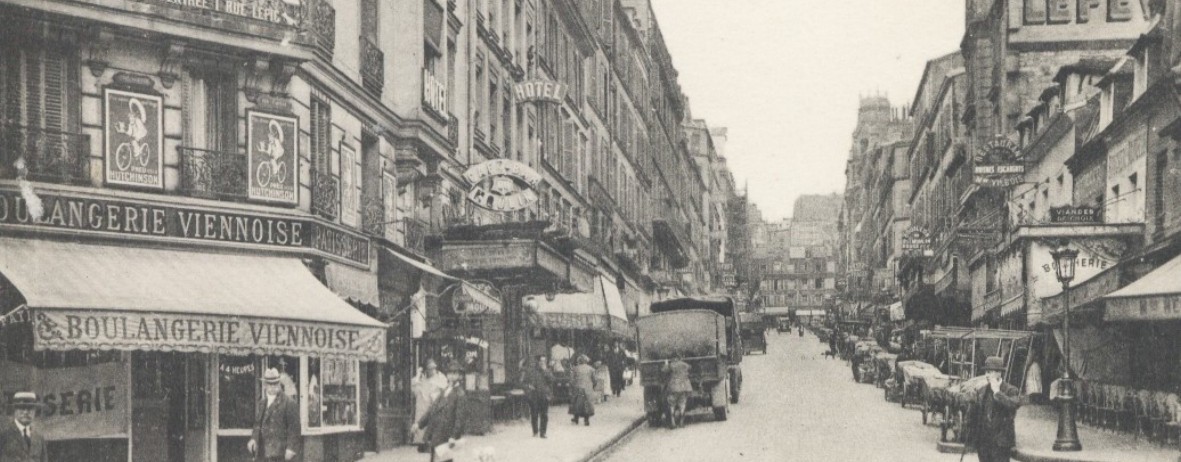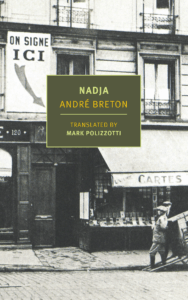
Art Imitates Life: Who Was the Real Woman Behind André Breton’s Nadja?
Mark Polizzotti Explores the Cultural Landscape of 1920s Paris Through the Eyes of the Surrealists and Their Muses
“Je ne peux finir”: I can’t finish. These enigmatic words, hastily scrawled on a sheet of café stationery, were the first I ever read by or about Nadja. The enticing glimpse of one of her letters to André Breton, reproduced on the cover of a French paperback, set the tone for a story that is so mysterious, so jarring, that to this day many believe it to be fiction—this, despite its author’s stated disdain for “psychological literature with its novelistic fabulations.”
On its surface, Nadja recounts Breton’s chance meeting and brief relationship with a self-described “wandering soul” in the autumn of 1926. But more than this, it provides the most compelling presentation ever written of what Breton calls “the Surrealist aspiration,” based on attunement to “petrifying coincidences” and the marvels of everyday life.
The first third of the book, with its philosophical musings, verdicts on literary predecessors, and curated autobiographical anecdotes involving Paul Éluard, Benjamin Péret, Robert Desnos, and other future pillars of the Surrealist movement—all of which might strike readers as mere throat clearing—is in fact an essential part of Nadja’s story, the context in which their meeting assumes its full significance.
Thirty years old at the time of this meeting, Breton was one of the most visible young authors on the French literary scene. His writings until then—including the automatic prose poem The Magnetic Fields, the essay collection The Lost Steps, and the Manifesto of Surrealism, which officially launched the movement in October 1924—were so many facets of an approach to living, one shared by Breton and his comrades in arms. The intent was not so much to create literature and art as to define, through literature and art, ways of seeing and doing that could reconnect with the lost wonder of childhood and counter centuries of rationalist thinking—the same rationalist thinking that had generated such horrors as the First World War, the repressive dominance of Catholic morality, and the wage-labor machine of capitalism. To couch this intent in purely invented terms would be beside the point, an obfuscation; rather, as Breton puts it, “I persist in demanding the names,” in living “in my glass house…where I sleep at night in a glass bed under glass sheets.”
While Nadja offers a weighted version of the facts…it is also the case that the book brings to life a fully realized, engaging, desiring, extraordinarily touching and charismatic woman.
To dispel all misconceptions to the contrary, then, Nadja was indeed a real woman, and this book is an almost entirely factual narration of a real relationship—though, as the author warns near the beginning, we should not expect “an exact account.” The two met more or less as described, the nine days of their principal contact—October 4 to 12, 1926—are related in sometimes astonishing detail (the combined result of Breton’s prodigious memory and timely note-taking), and, for those seeking further evidence, the volume contains forty-four documentary photographs of people, places, and items of interest, conceived from the outset as an integral element of the narrative.
Yet amid all the scrupulous documentation, one key piece is missing, one specific that would have laid to rest the decades of doubt and speculation that followed Nadja’s publication in 1928: the face and identity of Nadja herself. For many years, that identity was kept rigorously concealed, locked away as a shameful family secret by Nadja’s heirs, as privileged information by Breton’s, giving rise to various theories and assertions: that she was actually the actress Blanche Derval, who is name-checked in the book; that “Nadja” is a composite of several women, or a stand-in for Breton himself; and so on. The truth was partially revealed in 2002, when an exhibition at the Centre Pompidou displayed a hotel bill containing Nadja’s family name, then more fully in 2009, after an exhaustive inquiry by the Dutch novelist Hester Albach led her to Nadja’s surviving granddaughter and a cache of previously unknown records; much of the following biographical information is based on her study.
Nadja was born Léona-Camille-Ghislaine Delcourt on May 23, 1902, in the aptly named town of Saint-André, a provincial suburb of Lille, near the Belgian border. She was the third child of Eugène-Léon and Mélanie Delcourt, following an older sister, Marthe, and a brother, Charles-Camille, who had died at the age of two. Eugène had come from a comfortable bourgeois background and was, as his daughter put it, a “weak” and spoiled man. A frustrated sculptor, having squandered his fortune, he worked as a typesetter for the local newspaper—a not terribly lucrative job that didn’t prevent him from indulging in luxuries the family could ill afford.
Mélanie, more industrious, had fled the poverty of her Belgian village, only to find herself laboring in a textile factory from five in the morning until late at night, six days a week. Léona was recruited early on to help support the family, but from her father she also learned about the fine arts and the supposed freedoms of an artistic life. After Saint-André was liberated at the end of the First World War, the seventeen-year-old Léona fell in love with a British officer, by whom she had a daughter, named Marthe like her older sister. The officer returned to England, Léona rejected a marriage proposal by the local butcher’s son, and her frantic parents offered to raise the infant on condition that the wayward teen decamp to Paris.
Lively, attractive, and curious, Léona in that spring of 1920 got her hair cut fashionably short, frequented cafés notorious for drug dealing and prostitution, and dabbled in the theater, with the vague ambition of becoming a seamstress. She had originally moved to the capital under the “protection” of an elderly industrialist (no doubt the man referred to in Nadja as Special Friend), who provided support in return for sexual favors, allowing Léona to bring money back to the family on her occasional visits north and to show off her chic new looks. By the time of her meeting with Breton, however, the protector and his support had evaporated, and Léona, now twenty-four, was living hand to mouth.
The attraction and fascination between Nadja and Breton seems to have been immediate and mutual. “I had never seen such eyes,” Breton writes of their initial encounter. “What can be going on in those eyes that is so extraordinary?” For her part, Nadja later wrote to Breton: “I recall the powerful image of our meeting…I see you walking toward me with that ray of gentle grandeur clinging to the locks of your hair—and your godlike gaze.” Irresistibly drawn but “expecting the worst” (that is, fearing she might be a prostitute), Breton invited the woman to a café. As if nothing were more natural for her than these chance encounters, she told him of her parents, her home in northern France, a boy she’d loved and left behind. She called herself Nadja, she said, “because in Russian it’s the beginning of the word for hope, and because it’s only the beginning.” (In fact, the name was most likely taken from the American music hall artist Beatrice Wagner, who at the time performed under the stage name Nadja the Topless Dancer.)
Over the next nine days, the two met daily, sometimes by arrangement, sometimes by accident, their words and interactions marked by a potent mix of wonder, synchronicity, and, at times, tedium—for Breton’s account does not avoid the moments when he found Nadja’s monologues tiresome, her behavior incomprehensible or simply irritating. The relationship soon turned physical, progressing from kisses in a taxi to a night in an out-of-town hotel.
What were they seeking in each other? Breton’s first-person account states unambiguously that, for him, Nadja’s way of being—her unearthly nonchalance regarding people, her name, even herself; her unpredictable wanderings; her seeming obliviousness to money and accepted custom; and most of all her utterances, a disquieting combination of the frivolous and the oracular—responded to an ideal that he had only partially glimpsed before this. Entranced by the woman’s acute intuition, her sometimes frightening ability to connect with his own thoughts, and what he took to be her unfettered lifestyle (which only partially masked a desperation to stay afloat in a city that had led her adrift), he describes her as “a free genius, like one of those ethereal spirits that certain magic practices allow you to engage with momentarily but that you could never subdue.” As for Nadja, it’s possible that Breton was at first for her a potential means of support, another “protector,” and she does not hide her dismay when he mentions being married.
But whatever her initial feelings or ambitions, she soon became engulfed in the attentions Breton paid her, trying with increasing anxiety to hold his interest even as he began pulling away. Though their first sexual encounter was followed by others, as Nadja’s letters make clear, the emotional investment was lopsided: the sad fact seems to be that by year’s end, while Nadja was suffering the torments of unfulfilled passion, Breton, whose marriage was faltering, seems mainly to have been stroking his ego. In November, he sadly reported to his wife, Simone Kahn Breton, who had been privy to their story since the beginning, that Nadja had fallen in love with him “in that grave and desperate way that perhaps I impose on her,” even as he guiltily acknowledged that “I do not love the woman, and in all likelihood I never will. She is only capable…of putting in doubt everything I do love and my way of loving. No less dangerous for all that.” More dismissively, he remarked to a friend that sex with Nadja “was like making love to Joan of Arc.”
“Can it be that this frantic pursuit ends here?” Breton asks after the culmination of their nine-day journey. Yes and no. Though their daily meetings had come to an end, the two remained in contact until the following March. Perhaps hoping to rediscover what had initially captivated him, Breton suggested publishing a book of Nadja’s writings and drawings, and asked to borrow her journals. But the fascination of the early days was gone, and more often than not their time together devolved into bitter spats.
Moreover, Breton found Nadja’s journals a disappointment, and the publication project fell by the wayside. Angry and offended, Nadja demanded them back: “Why did you force me to hand over my little kitchen sink woes—André, I knew it—you found it all rather pedestrian.” And while Breton had earlier communicated his excitement to his friends—the Surrealist writer Pierre Naville recalled that Nadja “was at first the subject of a collective emotion, the kind Breton was so good at inspiring”—she now became a source of embarrassment. On one occasion, Breton brought Nadja unannounced to the Galerie Surréaliste, the group’s exhibition and gathering space, on a day when Naville and Simone were present: “She truly is a strange woman,” Naville reported. “Fantastic eyes that change shape, and talking exactly as [Breton] said.” At the same time, he couldn’t help noticing that Breton had begun to “lose patience with her.” Nadja herself appeared ill at ease in front of Simone, “not knowing what tone (what words) to use when talking about André.”
As autumn turned to winter, Nadja’s financial situation grew increasingly dire. Wishing to please Breton, she had stopped resorting to her former means of obtaining money (gifts from admirers, at least one instance of drug trafficking). She spent the Christmas season of 1926, at his urging, going from one squalid hotel to another in search of cheaper accommodations, finally settling on the Hôtel Becquerel in Montmartre, not far from the Bretons’ apartment on rue Fontaine. Several times in the book, Breton speaks of helping Nadja as much as his own finances would allow, once selling a Derain from his and Simone’s collection to pay her rent. “The vacant space this painting leaves on the wall will be a thousand times more precious than the painting itself,” he rationalized to his wife.
Nadja’s letters to Breton during those months, by turns fraught, seductive, furious, and pragmatic, and fluctuating between an intimate tu and a formal vous, form a litany of emotional highs and lows, as she vacillated between desolation at having lost her lover’s attentions, rage at feeling abandoned, outright fantasy, and rekindled hope in their shared future.
Six months later, Nadja was discovered screaming in terror in the corridor of her hotel, having seen men on the roof (in an ironic echo of a scene Breton reports in the book—and which might in fact have been workmen on the neighboring rooftop, rather than the hallucination commonly supposed). She was brought to the police prefecture in Place Dauphine and committed to Sainte-Anne mental hospital that same day, with a lengthy diagnosis that included anxiety, manic depression, and the conviction that outside forces were sending her odors and shooting electricity through her body; three days later, she was admitted to the Perray-Vaucluse hospital in the southern Paris suburb of Épinay-sur-Orge. Breton, learning of Nadja’s internment—and despite a long-standing assumption to the contrary, as well as his own representation in the book—apparently tried to visit her, as evidenced by an undated letter to him from a Dr. Gilbert Robin, but without success.
Nadja’s parents, on the other hand, did travel to Perray-Vaucluse, on March 27, and spent the next fourteen months petitioning her doctors to send their daughter closer to home. Finally, on May 16, 1928, one week shy of her twenty-sixth birthday, Léona Delcourt was transferred to the psychiatric hospital in Bailleul, about twenty miles from Saint-André, with a diagnosis of schizophrenia. Nine days later, Nadja was published by the prestigious literary house of Gallimard.
*
Breton had begun taking notes on his encounters with Nadja soon after the halt in their relations in October, but it wasn’t until August of the following year that he began to work in earnest on a book about her. The idea had occurred early, to both of them. “André? André?…You’ll write a novel about me,” Breton reports Nadja saying. “Beware: everything fades, everything disappears. Something of us must remain…You’ll find a Latin or Arabic pseudonym. Promise me. You have to.” And, in a letter: “You’ll use me and I’ll do my best to help you make something good.” But Breton wanted none of pseudonyms or novels, and when Nadja saw his notes for the book, her reaction was one of shock and hurt. “How could you write such mean-spirited deductions of what we were without the breath leaving your body?” she wrote him on November 1. “And how could I read this report—glimpse this distorted portrait of myself, without rebelling, or even weeping?”
Breton’s life at this time was one of conflict and distraction. His attempts since 1925 to make common cause with the French Communist Party, including briefly joining the Party itself, frequently ran afoul of the Communists’ skepticism toward the Surrealists, whom they considered mere bourgeois dilettantes. These tumultuous dealings had reached a crisis point in late 1926 and early 1927, which partly (but not entirely) explains the infrequency of Breton’s visits to Nadja, as lamented in her letters. At the same time, Breton’s marriage to Simone was foundering, due in part to his long and unrequited infatuation with the poet and socialite Lise Meyer (later Lise Deharme), the “lady of the glove” mentioned in Nadja—an infatuation that lasted nearly three years, during which time Breton lurched from hope to despair, each mood swing duly reported to his tolerant wife.
It was both to be near Lise, who was renting a house in nearby Pourville, and to begin writing Nadja that Breton, in early August 1927, took a room alone in the Norman resort town of Varengeville-sur-Mer at the Manoir d’Ango, a sixteenth-century château, famous for its magnificent tiled dovecote and loggia, that now served as a tourist inn. Work got off to a slow start: his fist two weeks at the manor were mainly spent reading—novels by Huysmans, a memoir of Victor Hugo—and visiting or receiving visits from friends, including his closest confidant, Louis Aragon, who was vacationing nearby and working on his own book, the sulfuric diatribe Treatise on Style. The fact that Aragon could toss off ten or fifteen pages in a day to his friend’s one or two further lowered Breton’s spirits.
Nonetheless, by mid-month he had begun drafting the opening episodes, reporting to Simone that the “generalities around Nadja” were “fairly interesting. I speak pretty coherently of things that are, I believe, rather exceptional.” Taking his cue from Freud’s case studies, Breton intended to create an atmosphere of clinical objectivity, later explaining that “the tone adopted for this narrative is copied from the one used in medical observations…without seeking to give its expression the least stylistic polish.” Still, however objective the surface, the drama of his relations with Nadja remains undimmed.
By September, Breton was back in Paris, having finished all but the concluding section. Encouraged by his friends’ enthusiastic reactions to the manuscript, he began gathering images to complement the text: Man Ray, the group’s unofficial portraitist, was commissioned to photograph individual Surrealists, while Ray’s assistant, Jacques-André Boiffard, matched Breton’s unadorned prose with eerily depopulated cityscapes (uncredited). Breton also began planning the third and final part, intended as a meditation on beauty—until a sudden disruption in his life yanked the book in an unexpected direction.
In November, Breton met with the writer Emmanuel Berl to discuss a joint publishing venture. Berl arrived at the meeting accompanied by his mistress, a “tall, slender, gracefully shaped” young woman (as one Surrealist described her) “with regular, slightly Nordic features…Very flirtatious and attractive.” It took only that one café meeting and a dinner at Éluard’s for Breton to fall desperately in love.
If Nadja is still worth reading, it is both for the bewitching qualities of its larger-than-life heroine and for the indelible portrait that Breton created of her.
Suzanne Fernande Muzard was born on September 26, 1900. Determined to leave behind the poverty of her youth, she had arrived in Paris three years earlier and gravitated to the brothel La Ruchette, where Berl had found her on one of his visits. He had settled her in his comfortable apartment and, as part of her “education,” given her books to read, among them the unfinished manuscript of Nadja, which he wanted to publish. Seduced by the book, Suzanne had asked Berl to introduce her to its author.
Within days, Breton had convinced Muzard to run away with him to the South, a trip he related to Simone in a series of long letters. “Suzanne is utterly exquisite,” he raved from a Toulon hotel. “This is the first time in a week I’ve left her side for even ten minutes.” But the idyll was short-lived: Suzanne had not let passion blind her to practical realities, and at the end of their trip she demanded that Breton leave his wife and marry her instead: “All or nothing.” Breton, unprepared for the thought of divorcing Simone, went home to rue Fontaine while Suzanne took a hotel room. Seizing his chance, Berl offered to take Suzanne abroad—but not before Breton, hearing of the departure at the last minute, rushed with several friends to the Gare de Lyon in an effort to stop them. Suzanne hesitated, impressed by this show of force on her behalf; but, urged on by Berl, she finally let the train carry her away.
It was after this incident that Breton wrote the conclusion to Nadja, centered on his meeting with and loss of his new beloved. Addressed only as “you,” Muzard comes to embody for Breton the summation and justification of Nadja’s clouded signal, the marvelous creature that Nadja had unwittingly prophesied. And just as he magnified Nadja, so now he magnified Suzanne, turning the book’s final pages into a manifesto on the power of beauty and sudden chance occurrences, ending with the now-famous credo: “Beauty will be CONVULSIVE or not at all.” More privately, Breton used his pages to rewrite events of the preceding days, casting beauty as “a train ceaselessly lurching from the Gare de Lyon, but that I know will never leave, has never left.”
In this alternate reality, subject to the logic of desire rather than of practicalities, Suzanne had not departed with his rival but rather stayed behind to consummate a passion without end. Reflecting on these pages several years later, Breton wrote that his relationship with Muzard “did not entirely kill in me the man to whom a vanishing Nadja, by a miracle of grace and selflessness, had perhaps entrusted her. That man…can imagine no disappointment in love, but he imagines and has never stopped imagining life—in its continuity—as the locus of every disappointment. It’s already rather curious, rather interesting that it should be so…”
*
From nearly the moment of its publication, Nadja became Breton’s most popular book, and today enjoys a reputation as the most famous literary work to come out of Surrealism. All well and good, but time, and the intensive research that fascination with Breton’s account and its heroine has inspired, have also laid bare some problematic aspects. For all its purported factuality, Breton’s narrative contains a number of inconsistencies. And despite his absorbing presentation of an exceptional woman, his story of Nadja is really the story of himself, of his frantic, relentless, sometimes oblivious pursuit of a world governed by marvels and not misery, in which Léona Delcourt becomes something of a philosophical stand-in, more embodiment than body. Because of his selective descriptions, the theorizing and conceptual airbrushing surrounding them, Breton has often been accused—I did so in my biography of him—of turning Nadja into a symbol, denaturing her, as Nadja herself charged in her letter of November 1.
And there is no doubt that the power dynamics between André—an established public intellectual, relatively comfortable if not exactly well off—and Léona—impoverished, infatuated, desperate—were anything but balanced. Still, I can’t help agreeing with Hester Albach’s argument that to label Nadja a victim “both does an injustice to Léona and underestimates Breton.” While Nadja offers a weighted version of the facts, in which the physical reality of Léona Delcourt risks becoming subsumed under the more wraithlike, almost spectral appearance of her chosen persona, it is also the case that the book brings to life a fully realized, engaging, desiring, extraordinarily touching and charismatic woman.
This is one of the reasons why Nadja continues to fascinate one hundred years after its first publication. A second is the resonant and enchanting portrait it offers of Paris, the book’s other major protagonist: an alternate Paris hidden in the day-to-day city, bristling with uncharted wonders, unexpected encounters, and disturbing, enticing spaces. On both these levels, the book remains an extraordinary writerly feat: once inside Breton and Nadja’s peculiar reality, with its mesmerizing events and petrifying coincidences, its dialogues that you can practically hear from the page, it becomes extremely difficult to leave. If Nadja is still worth reading, it is both for the bewitching qualities of its larger-than-life heroine and for the indelible portrait that Breton created of her, of himself, and of a city in which it was still possible to envision marvelous occurrences.
__________________________________

From Nadja by André Breton, translated from the French by Mark Polizzotti. Copyright © 2025. Introduction © 2025 by Mark Polizzotti. Available from New York Review Books.
Mark Polizzoti
Mark Polizzoti has translated more than fifty books from the French, including Invisible Ink and nine others by Modiano.












